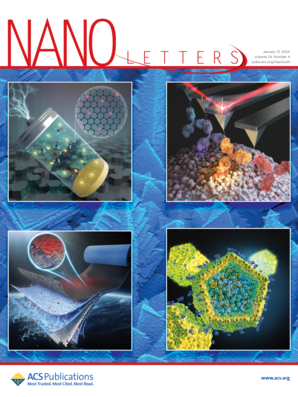Ultrafast Bright-to-Dark Exciton Relaxation in Bilayer Borophene Driven by Strong Excitonic Effects.
IF 9.6
1区 材料科学
Q1 CHEMISTRY, MULTIDISCIPLINARY
引用次数: 0
Abstract
Exciton dynamics in the recently discovered bilayer borophene (BL-α5, consisting of two stacked v1/12 boron sheets) are of great interest due to this material's promising electronic and optical properties for nano-optoelectronic applications. Using a GW plus real-time Bethe-Salpeter equation (GW-rtBSE) approach and ab initio nonadiabatic molecular dynamics (NAMD), we identify a Frenkel-type lowest-energy bright exciton and a spatially delocalized dark exciton in BL-α5, with large binding energies of ∼700 and ∼502 meV, respectively. The electron-hole (e-h) Coulomb interaction (exciton effect) dominates over electron-phonon (e-ph) scattering, playing a pivotal role in an ultrafast bright-to-dark exciton transition with a relaxation time of ∼150 fs. Furthermore, the dark excitons undergo nonradiative recombination on a picosecond time scale (∼14 ps at room temperature). These results provide a theoretical foundation for potential nano-optoelectronic and light-energy harvesting applications of bilayer borophene.由强激子效应驱动的双层硼罗芬中超快亮-暗激子弛豫。
最近发现的双层硼烯(BL-α5,由两个堆叠的v1/12硼片组成)的激子动力学引起了人们的极大兴趣,因为这种材料在纳米光电应用中具有很好的电子和光学特性。利用GW +实时Bethe-Salpeter方程(GW- rtbse)方法和从头算非绝热分子动力学(NAMD)方法,我们在BL-α5中发现了一个frenkel型最低能量亮激子和一个空间离域暗激子,它们的结合能分别为~ 700和~ 502 meV。电子-空穴(e-h)库仑相互作用(激子效应)支配着电子-声子(e-ph)散射,在弛豫时间为~ 150fs的超快亮-暗激子跃迁中起着关键作用。此外,暗激子在皮秒时间尺度(室温下约14 ps)进行非辐射复合。这些结果为双层硼罗芬在纳米光电和光能量收集方面的潜在应用提供了理论基础。
本文章由计算机程序翻译,如有差异,请以英文原文为准。
求助全文
约1分钟内获得全文
求助全文
来源期刊

Nano Letters
工程技术-材料科学:综合
CiteScore
16.80
自引率
2.80%
发文量
1182
审稿时长
1.4 months
期刊介绍:
Nano Letters serves as a dynamic platform for promptly disseminating original results in fundamental, applied, and emerging research across all facets of nanoscience and nanotechnology. A pivotal criterion for inclusion within Nano Letters is the convergence of at least two different areas or disciplines, ensuring a rich interdisciplinary scope. The journal is dedicated to fostering exploration in diverse areas, including:
- Experimental and theoretical findings on physical, chemical, and biological phenomena at the nanoscale
- Synthesis, characterization, and processing of organic, inorganic, polymer, and hybrid nanomaterials through physical, chemical, and biological methodologies
- Modeling and simulation of synthetic, assembly, and interaction processes
- Realization of integrated nanostructures and nano-engineered devices exhibiting advanced performance
- Applications of nanoscale materials in living and environmental systems
Nano Letters is committed to advancing and showcasing groundbreaking research that intersects various domains, fostering innovation and collaboration in the ever-evolving field of nanoscience and nanotechnology.
 求助内容:
求助内容: 应助结果提醒方式:
应助结果提醒方式:


